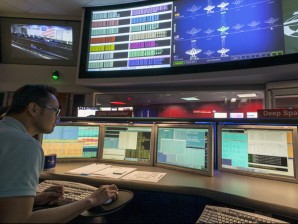
This Aug. 2, 2012 file photo shows Nick Lam, data controller, monitoring the Mars rover Curiosity from the Deep Space Network’s control room at NASA’s Jet Propulsion Laboratory in Pasadena, Calif. NASA’s Curiosity rover is zooming toward Mars. With about a day to go until a landing attempt, the space agency says the nuclear-powered rover appears on course. AP/Damian Dovarganes, File
LOS ANGELES—With a mixture of tense nerves and confidence, NASA counted down Sunday to the landing of its largest ever robotic rover on Mars, where it will search for signs that life may once have existed.
The $2.5 billion Mars Science Laboratory, featuring a car-sized rover called Curiosity, is expected to land on Mars at 0531 GMT on Monday (10:31 pm Sunday on the US West Coast).
However, success is anything but certain with this first-of-its-kind attempt to drop a six-wheeled chemistry lab by rocket-powered sky crane on an alien planet. NASA’s more recent rover dropoffs were done with the help of airbags.
“We are rationally confident, emotionally terrified and ready for EDL,” said NASA engineer Adam Steltzner, leader of the US space agency team tasked with entry, descent and landing (EDL), a process NASA has called “Seven Minutes of Terror.”
In these final moments, the spacecraft should accelerate with the pull of gravity as it nears Mars’ atmosphere, making a fiery entry at a speed of 13,200 miles (21,240 kilometers) per hour and then slowing down with the help of a supersonic parachute.
After that, an elaborate sky crane powered by rocket blasters kicks in, and the rover is due to be lowered down by nylon tethers, hopefully landing upright on all six wheels.
Scientists do not expect Curiosity to find aliens or living creatures. Rather they hope to use it to analyze soil and rocks for signs that the building blocks of life are present and may have supported life in the past.
The project also aims to study the Martian environment to prepare for a possible human mission there in the coming years.
It has already been collecting data on radiation during its eight and a half month journey following launch in November 2011 from Cape Canaveral, Florida.
Mars program director Doug McCuistion called the science “absolutely crucial” to finding out if Earthlings are alone, how Mars evolved from a wet to a dry planet and how accessible Mars may be for human explorers in the future.
“If we succeed, it will be one of the greatest feats in planetary exploration ever,” he told reporters. “Our success rate has been pretty darn good recently.”
However, he cautioned that “these things are really hard to do” and admitted that “we may not be successful.”
Attempts by global space agencies since 1960 have resulted in a near 40 percent success rate in sending landers, orbiters or other spacecraft for flybys to Mars. NASA has the best record.
“A failure is a setback, it is not a disaster,” McCuistion said, vowing that if it does not work, NASA would learn from its mistakes and press forward with Mars exploration.
In the meantime, members of NASA’s flight team at the Jet Propulsion Laboratory in Pasadena, California, clung to their good luck charms as the rover sped toward Mars at a rate of 8,000 miles per hour.
One staffer groomed his long sideburns, which he has been growing in anticipation of the landing; another held a pair of her cherished trinkets close for good luck; and a third colored his hair red and blue and styled it in a mohawk, with stars on the sides to represent the American flag.
These small traditions aim to “keep the mood light and also result in some good luck for Curiosity,” said Brian Portock of NASA’s flight team.
Portock added that NASA had decided last minute corrections to the flight path were not necessary overnight, and said communications with the spacecraft were very good.
“In cell phone speak, we have a full set of bars,” he said.
The weather on Mars was also promising, with a nearby dust storm that was spotted days ago all but gone now.
“We’ve got great weather for landing,” said Steltzner.
The announced landing time is 14 minutes after the touchdown occurs, with a delay due to the time it takes signals to travel from Mars to the Earth.
The US space agency said it will air a live commentary on NASA television beginning at 0400 GMT.

